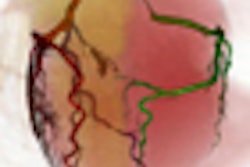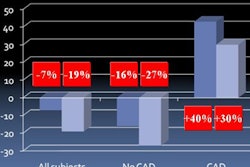A new American Heart Association (AHA) committee statement on the use of coronary CT angiography (CTA) and MR angiography (MRA) recommends against screening asymptomatic individuals for coronary artery disease.
The statement, which has been in the works for years and therefore doesn't include the latest research developments, urges very cautious use of the modalities, highlighting the need for more research, careful reporting of trial results, and improved technology.
In its statement in the July 29 issue of Circulation (published online June 27), members of a group of AHA committees, led by lead author Dr. David Bluemke from Johns Hopkins University in Baltimore, cite the progress and continuing limitations of the two noninvasive heart imaging modalities.
MRA
MRA's lack of contrast and ionizing radiation generally favor the modality over CTA, the authors noted, but MRA's lack of spatial resolution, longer exam times, and generally reduced availability are drawbacks, they wrote. In addition, contraindication of the exam in patients with metal implants renders CTA a quicker, more all-purpose test.
"Technical improvements in coronary MRA include the development of MR methods that generate improved coronary signals and support reduced scanning times while simultaneously minimizing the complexity of the examination," Bluemke and colleagues wrote. Whole-heart coronary MRA, though it provides slightly lower resolution than focused exams, "has gained rapid acceptance on the basis of promising initial results."
Graft evaluation remains challenging for MRA due to a lack of spatial resolution and the frequent presence of metal clips. "Although coronary MRA has been successfully used for identification of graft occlusion, the inability to identify various degrees of luminal narrowing in diseased yet patent grafts is also a hindrance to clinical utility and acceptance," the article stated.
The authors cited studies indicating an important role for coronary MRA in the assessment of coronary artery aneurysms, most commonly due to Kawasaki disease. Among several other promising indications, the authors noted a role for the identification of left-main or multivessel disease for MRA. Also promising are intravascular, or "blood-pool" contrast agents, which have "the advantage of allowing image acquisition over longer time periods."
CTA
As for coronary CTA, the study group cited the modality's spatial resolution, which is superior to MRA and continuously improving, and fast exam times, with contrast and radiation exposure cited as the main drawbacks.
"The spatial resolution of the present 64-slice MDCT scanners is 0.4 mm," they wrote. "This is an improvement over the 0.7-mm resolution of 16-slice MDCT but not as high as can be obtained with catheter-based cine angiography (0.3 mm)."
Meta-analyses of 64-slice MDCT studies have yielded sensitivities and specificities as high as 93% and 96%, respectively, with less-impressive results of 86% and 96%, respectively, in others. Enrollment procedures have improved since the early studies, the AHA group reported, with fewer patients being excluded inappropriately and nonevaluable segments increasingly included in the analyses, rendering more meaningful results. Stent size remains a limitation for the evaluation of in-stent restenosis.
Coronary CTA's principal advantage is in stenosis detection, they noted. "The presence of hemodynamically relevant coronary artery stenoses in patients without stents and bypass grafts may be ruled out by MDCT with a high negative predictive value (between 98% and 100% in most studies)," Bluemke and colleagues wrote.
Among CTA's drawbacks, the authors cited the occurrence of (mainly) false-positive results resulting from the presence of extensive calcifications. Intravenous injection is associated with compromised renal function in some patients, and rarely, more serious anaphylactoid reactions.
Also noted were the radiation risks of coronary CTA. Recent studies on 64-slice scanners report doses of 10 to 14 mSv with electrocardiogram (ECG)-triggered tube-current modulation.
"Using higher pitch and greater time per cardiac cycle during which tube current is reduced by tube-current modulation may substantially reduce the radiation dose received from coronary CTA with dual-source CT scanners," they wrote. ECG-controlled tube-current modulation, reducing x-ray tube current while scanning the anterior-posterior plane, and placing bismuth-coated latex shielding over breast tissue were also suggested for radiation dose reductions of up to 40%.
The detection of noncalcified plaque was cited as an important future direction for both modalities.
"Most ruptures occur in plaques containing a soft, lipid-rich core covered by a thin, inflamed fibrous cap," they wrote.
The lack of intervention options following the detection of disease was cited as a drawback of both tests.
"Coronary MRA and CTA are purely diagnostic tests that do not provide an option for immediate intervention and do not presently serve as the only basis for performing coronary artery bypass surgery," Bluemke and colleagues wrote.
Reporting
CTA and MRA reporting "should provide as much information as possible using terminology similar to that used in the reporting of catheter-based angiography," the group advised. Reports should include discussions of the technical quality of the exam and careful reporting of lesions and locations.
In CTA, vessels of 1.5 to 2 mm in diameter can be assessed for atherosclerotic narrowing and should be reported.
Thin-section maximum-intensity projections may be useful for assessment, "but should not be the only data assessed for reporting purposes given the potential for missing coronary lesions due to overlapping high-density structures that may obscure lumen narrowing," the committee authors cautioned.
In addition, physicians should comment on the origin and course of the epicardial vessels and whether the coronary artery system is right- or left-dominant, they wrote.
Recommendations
Owing to the risks and expenses, the authors advised against the routine screening of patients with both low and high probability of disease.
"With present technology, use of MDCT coronary CTA in a population that is at very low risk for coronary artery disease is inappropriate, because the risk associated with the radiation exposure may exceed the potential benefit of the CTA," the group stated. "In patients with a high pretest probability of coronary stenoses, a clinical benefit of MDCT coronary angiography is unlikely, given the increased likelihood that interventional treatment (invasive angiography or bypass surgery) will be necessary. In the case of equivocal stress-test results, it is conceivable but unproven that MDCT coronary CTA may facilitate a decision for or against invasive coronary angiography. Screening of asymptomatic individuals concerning the presence of coronary artery stenoses is not justified at present."
The authors cited the chief advantages of coronary CTA compared with MRA as wider availability, higher spatial resolution, and more consistent, shorter examinations with better patient adherence. MRA's advantages are a lack of ionizing radiation and a lack of administration of iodinated contrast material.
"Both tests are presently suboptimal for patients with atrial fibrillation and other arrhythmias, and image quality may be further reduced by high body mass," they wrote. In addition, they note that neither test has been proved in outcomes-based analyses.
"Neither coronary CTA nor MRA should be used to screen for coronary artery disease in patients who have no signs or symptoms suggestive of coronary artery disease," the group advised. "The potential benefit of noninvasive coronary angiography is likely to be greatest and is reasonable for symptomatic patients who are at intermediate risk for coronary artery disease after initial risk stratification, including patients with equivocal stress-test results. Diagnostic accuracy favors coronary CTA over MRA for these patients."
Anomalous coronary artery evaluation can be performed by either modality; however, radiation-protection concerns indicate that MRA is preferred when available.
Researchers should report on the technical quality of exams, as well as vessel size, description of coronary anomalies, stenoses, and significant noncardiac findings within the field-of-view, they advised.
Additional multivendor and multicenter research will also be needed to validate both techniques, Bluemke and colleagues wrote.
"Continued research in cardiac CT and MR imaging is encouraged to determine the potential of these noncatheter-based modalities to detect, characterize, and measure atherosclerotic plaque burden, as well as its change over time or as the result of therapy," they wrote.
Comments from an author
"Overall it's a nice review, carefully done by good investigators, but it's a little on the conservative side, and this field is advancing so quickly that the publication lag means it lacks more recent information," said co-author Dr. Matthew Budoff, an associate professor of medicine at the University of California, Los Angeles, and director of the Harbor-UCLA LA BioMed CT Reading Center in Torrance, CA.
Specifically, he said, the report was compiled before prospectively gated triggering techniques that greatly reduce the coronary CTA radiation dose came into widespread use. In light of this development, recommendations against screening low-risk patients may be ill-advised, he said.
"We clearly don't want to incur more cancer without finding heart disease, but now with radiation doses down in the 1-2 mSv range, the radiation risk [from CTA] is largely removed," Budoff told AuntMinnie.com. "Newer data suggest that low-risk populations may not be as low-risk as previously identified by Framingham."
By Eric Barnes
AuntMinnie.com staff writer
July 9, 2008
Related Reading
Nearly all CABG surgeries in northern New England appropriate, June 16, 2008
CMS makes no change to coronary CTA payments, March 12, 2008
Coronary CTA's time is now, according to Dowe, January 17, 2008
CTA finds serious incidental findings after CABG surgery, August 6, 2007
Radiation dose slashed in 64-slice coronary CTA, February 15, 2007
Copyright © 2008 AuntMinnie.com



















